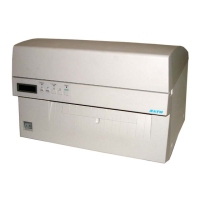Section 1. Programming Concepts
Page 1-2 SATO Programming Reference
These commands set the operational parameters of the printer, like “set the print
speed to 3.”
<ESC> {Command} {Parameter} {Data}
Some commands can contain both Parameter and Data elements, such as “print a
Code 39 symbol containing the data.”
SELECTING PROTOCOL CONTROL CODES
Protocol codes are the special control characters that prepare the printer to receive
instructions. For example, the <ESC> character tells the printer that a command code
will follow and the <ENQ> character asks for the printer status. There are two
pre-defined different sets of Protocol Control codes to choose from. Each set is made
up of six special characters. The Standard Protocol Control codes are non-printable
characters, and the Non-Standard Protocol Control codes are printable characters.
The Non-Standard set may be useful on host computers using protocol converters or
in an application where non-printable ASCII characters cannot be sent from the host.
This manual uses the Standard Protocol Control codes for all of the examples.
Alternately, the user may define and download a set of custom Protocol Control
Codes (see Appendix E).
The Protocol Control codes are selected by DIP switch DSW2-7.
USING BASIC
It may be useful to test your printer using a BASIC program on a PC. You may also
write your actual production programs in BASIC. Whatever the reason, if you will be
working in BASIC, some of the following hints may help you get started:
1. Set the WIDTH of the output device to 255 characters to avoid automatically
sending <CR> and <LF> characters after every line. The command string should
be continuous and uninterrupted by <CR> and/or <LF> commands. The examples
given in this manual are printed on separate lines because they will not fit on one
line and do not contain any <CR> and/or <LF> characters. If these characters are
needed, they are explicitly noted by the inclusion of <CR> and<LF> notations.
CONTROL
CHARACTER
STANDARD
DSW2-7 OFF
NON-STANDARD
DSW2-7 ON
DESCRIPTION
STX 02 Hex 7 B Hex = { Start of Data
ETX 03 Hex 7 D Hex= } End of Data
ESC 1B Hex 5 5 E Hex = Command code to follow
ESC 1B Hex 5E Hex = ^ Command code to follow
ENQ 05 Hex 40 Hex = @ Get printer status, Bi-Com mode
CAN 18 Hex 21 Hex = ! Cancel print job, Bi-Com mode
Off-Line 40 Hex 5D Hex = ] Take printer Off-Line

